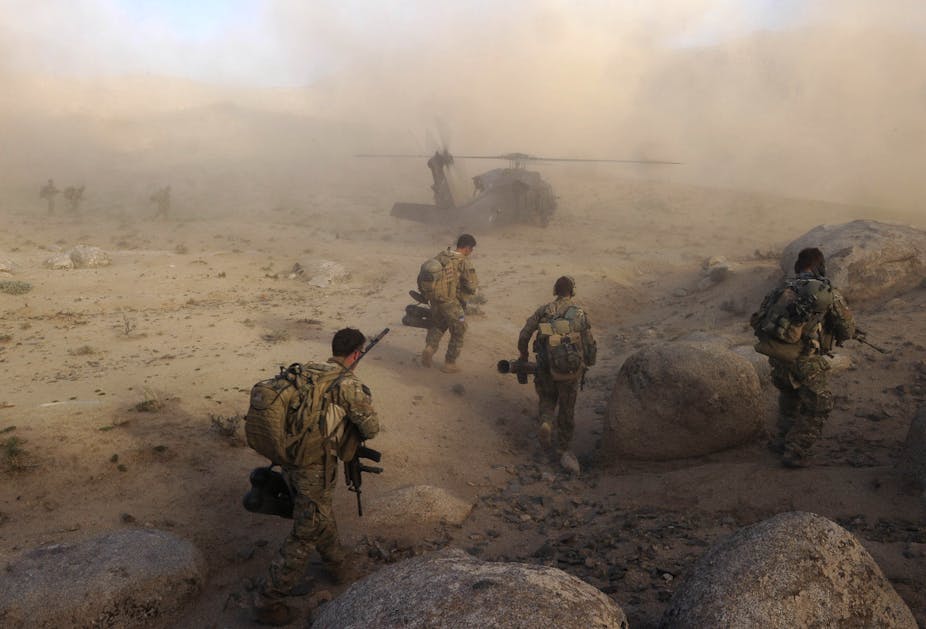Recently, legitimate concerns about the media coverage of Australia’s military involvement in the war in Afghanistan have been raised. It is true that much more that can and should be said about the army’s past, present and future activities has so far been ignored.
Explicitly excluded from the government-commissioned histories of Australia in war is any reference to Australia’s involvement in East Timor, Iraq or Afghanistan. In an age of unprecedented openness and interconnectivity, this is a travesty that must be rectified.
One attempt has been made to explain what the Australian Army has been doing in Afghanistan and elsewhere in operations in the post-Vietnam War years: how it has done it, why it has done so and what it might mean for the army and the defence force of today and tomorrow.
My new book, entitled The Australian Army from Whitlam to Howard, explores the “casualty cringe” felt by political leaders following the Vietnam War and its impact on subsequent operations.
One obvious effect relates to the observations made by academic Kevin Foster in The Conversation and defence correspondent Michael Brissenden in ABC’s The Drum about the army’s media aversion. The reputation of the US armed forces suffered heavily as a result of major Vietnam War atrocities such as the massacre in the village of My Lai, where hundreds of Vietnamese citizens were murdered by American troops. The Australian Army was not involved in incidents like that, as historian Ashley Ekins’ accounts of the Vietnam War attest.
But despite the high standards of professionalism displayed by the Australian forces, the dominance of American media images effectively sullied the reputation of the Australian forces in Vietnam by association. We live with the legacy of that knock-on effect.

The Australian Army slowly regained its confidence after Vietnam through a series of peacekeeping-related operations from the end of the Cold War onwards in Namibia, Somalia, Rwanda and Cambodia. The moniker “ambassador, teacher, soldier, peacekeeper” came into use, associated with images of Australian soldiers helping those most in need.
These operations provided the grounding for the army and the wider defence force to play leading roles in East Timor, Bougainville and the Solomon Islands, and to contribute to combat operations further afield. I argue that the army’s rehabilitation has gone largely unheralded as a result of the lack of media coverage and a misplaced concern over operational security and political sensitivities. But there is much more of the story to tell.
Part of the difficulty in reporting on the Afghanistan War and other conflicts involving the Australian Army over the last couple of decades is that the task of integrating new military operations into the broader narrative of Australia’s military history has been made difficult because they did not fit the mould of earlier operations such as the Vietnam War or World Wars One and Two.
There is an important story to share of how the army has adapted and been successful over this period. There are a number of reasons why it has adapted so well, including individual and collective training, regimental or corps identities, ties with close allies and regional partners, as well as links with Australian society.
At a time when the Australian Army’s decade of continuous operations is drawing to an end – and as the “Asian century” gathers pace – the army’s strategic role is once again the subject of some debate. Many foresee some parallels to the era following the end of the Vietnam War – reduced budgets and a greater political reluctance to deploy forces overseas.
At the same time, significant capital investment is being made in air and naval platforms. The role of the army in a “maritime strategy” is a topic currently engaging the minds of the army’s highest echelons.

Australia has an enduring interest in, and can be expected to continue to support, a rules-based global order and will likely contribute to a range of endeavours that seek to realise a more just and peaceful world. The broad range of military operations and activities conducted between 1972 and 2007 demonstrate this.
Previously, the Australian government has commissioned official historians to tell the story of the army’s role in a conflict. C.E.W. Bean, for instance, authored much and edited all of the 15-volume history of Australia’s involvement in World War One. This, and the other histories of Australia’s wartime activities, are significant and authoritative accounts.
More recently, leading historians led by Professor David Horner have been commissioned to write a six-volume history of Australia’s peacekeeping, humanitarian and post-Cold War operations. This is well in train, with one volume out and more on the way.
But there are more stories that must be told, authoritatively and dispassionately, so that the Australian people can understand what their armed forces have done and why they have done it.
The Australian Army from Whitlam to Howard will be launched by former prime minister John Howard on December 11 in Sydney.

